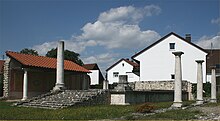Apollo Grannus Temple
The Apollo-Grannus-Tempel was a Roman temple in Faimingen near Lauingen in Bavaria . Emperor Caracalla asked the god Apollo Grannus to heal his ailments there in 212. The name of the temple is based on that of the Roman god of healing Apollo and the source and bath god Grannus of the Celts . The clear spring water contributed to the supra-regional importance of Phoebiana (Roman for “Faimingen”) for cult baths and drinking cures. The temple, of which only remains exist today, is one of the largest Roman temples north of the Alps. An open-air museum was therefore built on the site in 1987 .
construction
In its heyday, Phoebiana is estimated to be around 40 ha. The temple itself is about 1000 m². The roads leading to Phoebiana ran towards the forum of the complex. At today's entrance in the south of the complex there is a medieval fountain (1). From here the steps of a staircase lead to the inner colonnade ( Portikus II ). In the extension you can see the ramp leading from the temple courtyard ( Temenos ) to the temple vestibule, the pronaos . This is followed by the main room, the cella . Eight of the original 14 columns of the portico surrounding the Tempelhof on three sides have been preserved or reconstructed. The western columns still show part of the wall to the outer portico ( portico I ) and are covered. Behind the temple there is a shop ( taberna ). Here are the remains of another medieval well (2). Only one of the pillars of the outer portico has been preserved in the western part. The former course of the colonnade is painted in white on the path.
excavation
The first excavations began in 1888 by the Faiming village teacher Magnus Scheller. In this and several subsequent excavations, the temple and the remains of the adjacent buildings were uncovered. The partial reconstruction visible today was made possible by the discovery of 150 ashlar stones in 1972 in the Brenz and the same number of spoils from the fort wall.
Ultimately, information about the name and purpose of the excavated findings was provided by the findings of two milestones under the parish church of the neighboring community of Gundelfingen an der Donau in 1981 and a third milestone with the same content in 2002 in Sontheim an der Brenz . The inscriptions on the milestones date from the year 212/213 and report construction work on roads and bridges on behalf of and probably at the expense of Emperor Caracalla. The place name Phoebiana is mentioned as the destination of the road , which was already known from late antique written sources and can now be identified with the modern Bad Faimingen through the inscription finds.
literature
- Wolfgang Czysz : The Apollo Grannus sanctuary in the vicus of Faimingen. In: Vera Rupp , Heide Birley (Hrsg.): Country life in Roman Germany. Theiss, Stuttgart 2012, ISBN 978-3-8062-2573-0 , pp. 119f.
- Hans Ulrich Nuber , Gabriele Seitz: The milestones of Caracalla from the year 212 AD on the road to (Aquae) Phoebianae / Faimingen. In: Jörg Biel , Jörg Heiligmann , Dirk Krausse (Hrsg.): Landesarchäologie. Festschrift for Dieter Planck for his 65th birthday (= research and reports on prehistory and early history in Baden-Württemberg. Volume 100). Konrad Theiss, Stuttgart 2009, ISBN 978-3-8062-2331-6 , pp. 303-321.
- Gerhard Weber: Faimingen, City of Lauingen / Danube, district of Dillingen ad Donau, Schw .: Fort and Vicus Phoebiana. In: Wolfgang Czysz u. a. (Ed.): The Romans in Bavaria. Nikol, Hamburg 2005, ISBN 3-937872-11-6 , pp. 441-444.
Web links
- Information about the temple complex on the homepage of the city of Lauingen
Individual evidence
- ^ Karlheinz Dietz : Two new milestones Caracallas from Gundelfingen, Ldkr. Dillingen ad Donau, Reg.-Bez. Bavarian Swabia. In: Germania . Volume 63, Number 1, 1985, pp. 75-86 ( digitized version ).
- ^ Anne Kolb : Caracalla and Raetien. In: Tyche . Volume 18, 2003, pp. 21-30.
- ↑ Hans Ulrich Nuber, Gabriele Seitz: The milestones of Caracalla from the year 212 AD on the road to (Aquae) Phoebianae / Faimingen. In: Jörg Biel, Jörg Heiligmann, Dirk Krausse (Hrsg.): Landesarchäologie. Festschrift for Dieter Planck on his 65th birthday. Konrad Theiss, Stuttgart 2009, ISBN 978-3-8062-2331-6 , pp. 303-321, here pp. 305 f. and p. 309 f.
Coordinates: 48 ° 33 ′ 42.1 ″ N , 10 ° 24 ′ 31.6 ″ E


